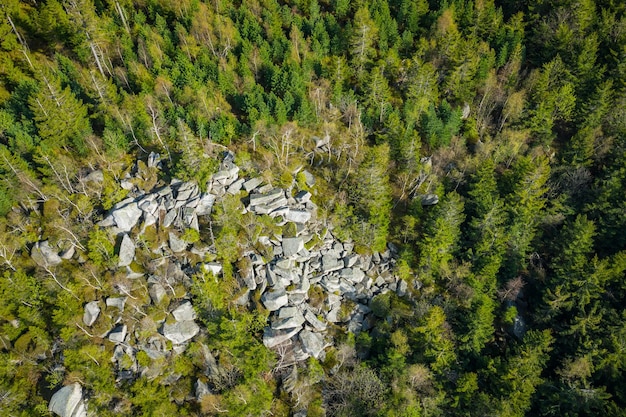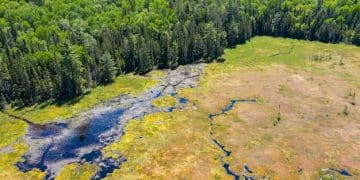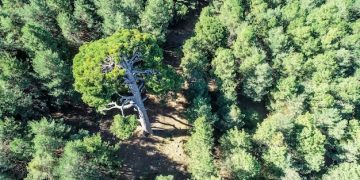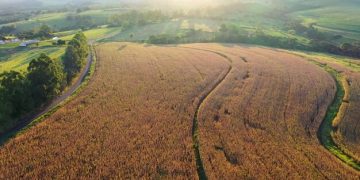US Deforestation Spike 8%: Carbon Credit Impacts Explained

A recent 8% surge in nationwide deforestation rates in the US poses significant challenges for carbon credit markets, potentially undermining their efficacy and demanding urgent reevaluation of conservation strategies and credit issuance protocols.
The latest alarming report reveals that deforestation across the United States has surged by a dramatic 8%. This significant increase raises critical questions about current environmental policies, land management practices, and, perhaps most notably, the integrity and future viability of the burgeoning carbon credit market. Understanding the multifaceted implications of this rise is crucial as we navigate the complex interplay between environmental conservation and economic incentives in a rapidly changing climate.
The Alarming Rise in US Deforestation: An 8% Spike Explained
The recent report detailing an 8% nationwide surge in deforestation rates across the United States has sent ripples of concern through environmental and economic sectors alike. This isn’t merely a statistic; it represents a tangible loss of vital ecosystems, a significant setback in climate mitigation efforts, and a direct challenge to the mechanisms designed to offset carbon emissions. Understanding the underlying drivers of this increase is crucial for developing effective countermeasures.
Key Drivers Behind the Deforestation Surge
Several interconnected factors contribute to the accelerated pace of forest loss in the US. While large-scale agricultural expansion, a prominent driver in other regions globally, is less dominant here, urban sprawl and infrastructure development play a significant role. The growing demand for housing, commercial real estate, and transportation networks often comes at the expense of forested areas, particularly near metropolitan centers.
- Urbanization and Infrastructure: The relentless expansion of cities and suburbs, coupled with the development of new highways and energy pipelines, converts forest land into developed spaces.
- Timber Harvesting Practices: While some forestry is sustainable, certain intensive logging practices, particularly clear-cutting without adequate reforestation, can contribute to net forest loss over time.
- Wildfires and Natural Disturbances: An increasing frequency and intensity of wildfires, often exacerbated by climate change and historic forest management, incinerate vast tracts of forest, hindering natural regeneration.
- Agricultural Conversion (Localized): Although less expansive than in tropical regions, localized agricultural conversion for specific crops or livestock operations can still contribute to forest loss in certain US areas.
Beyond these direct causes, economic pressures and policy deficiencies can indirectly fuel deforestation. Fluctuations in commodity prices, for instance, can incentivize landowners to convert forested land for higher-value uses. Furthermore, a patchwork of zoning laws and environmental regulations across states means inconsistent protection, leading to areas where forests are more vulnerable to development. The 8% increase is a stark reminder that even in a highly developed nation, forests remain under significant threat from various anthropogenic and natural pressures. Its implications extend far beyond ecological boundaries, touching upon economic stability, social equity, and the very air we breathe.
Understanding Carbon Credits: A Mechanism Under Pressure
Carbon credits, also known as carbon offsets, represent a powerful, market-based approach designed to reduce greenhouse gas emissions. Fundamentally, one carbon credit equals one tonne of carbon dioxide (CO2) removed or avoided from the atmosphere. These credits are generated by projects that either sequester carbon (like reforestation and afforestation) or prevent emissions (like renewable energy installations or methane capture from landfills). Companies or individuals can then purchase these credits to compensate for their own unavoidable emissions, effectively “offsetting” their carbon footprint.
The underlying principle is straightforward: incentivize activities that benefit the climate by making them economically viable. Developers of carbon-reducing projects can sell the generated credits, providing a financial return that supports their environmental efforts. Buyers, on the other hand, can meet emission reduction targets or voluntarily demonstrate environmental responsibility.
Types of Carbon Credits and Their Provenance
Carbon credits broadly fall into two main categories: voluntary and compliance markets.
- Voluntary Carbon Market (VCM): In the VCM, businesses and individuals voluntarily purchase carbon credits to offset their emissions, driven by corporate social responsibility, brand image, or personal environmental goals. Projects in the VCM range from direct air capture technologies to forest conservation and sustainable agricultural practices.
- Compliance Carbon Market (CCM): The CCM is established by regulatory bodies (governments or international agreements), which set a cap on total emissions and issue permits (allowances or credits) that companies must hold to cover their emissions. Examples include the European Union’s Emissions Trading System (EU ETS) or California’s Cap-and-Trade program.
The value and integrity of carbon credits heavily rely on the robustness of their verification process. Reputable standards bodies like Verra (Verified Carbon Standard), Gold Standard, and the American Carbon Registry ensure that projects genuinely deliver the claimed carbon benefits. This verification process typically involves rigorous methodologies for measuring, reporting, and verifying emissions reductions or removals, as well as ensuring that projects adhere to principles of additionality (the benefit wouldn’t have occurred anyway), permanence (the benefit is long-lasting), and leakage avoidance (the project doesn’t just shift emissions elsewhere). The recent deforestation spike directly challenges the permanence and additionality of land-based carbon projects, particularly those related to forest preservation and CO2 sequestration.
The Direct Link: How Deforestation Undermines Carbon Markets
The 8% surge in US deforestation rates introduces a significant and immediate challenge to the integrity and effectiveness of the carbon credit market, particularly for nature-based solutions. Forests are often referred to as the “lungs of the Earth,” acting as massive carbon sinks. When trees are cut down or burned, they release stored carbon back into the atmosphere, transforming a carbon-absorbing asset into a carbon-emitting source. This dynamic directly impacts the equation that underpins carbon credits.
For projects designed to sequester carbon through forest preservation (avoided deforestation) or reforestation, increased deforestation elsewhere in the country can nullify their intended planetary benefit. If a company invests in credits from a reforestation project in one state, but a greater area of forest is lost due to urban sprawl or logging in another, the net environmental gain is diminished or even reversed. This phenomenon is known as “leakage” – where protection in one area leads to increased deforestation in another – and presents a critical risk to the credibility of any carbon offset claim.
Impacts on Credit Validity and Trust
The rising deforestation rates can fundamentally erode trust in carbon credits. If the public and investors perceive that overall forest cover is decreasing despite investments in forest-based credits, the very notion of achieving “net-zero” through offsets becomes questionable. This scepticism can lead to:
- Reduced Demand: Companies and individuals may become reluctant to purchase carbon credits if they doubt their real-world impact, slowing down investment in climate solutions.
- Price Depreciation: A loss of confidence in the market’s integrity can drive down the value of carbon credits, making it less attractive for project developers to embark on new initiatives.
- “Greenwashing” Accusations: Businesses that rely heavily on carbon offsets to meet sustainability targets may face accusations of “greenwashing” if the broader environmental context suggests a worsening trend in forest cover.
Beyond these direct impacts, the permanence of carbon storage in forests is jeopardized. A forest that is protected today but vulnerable to future conversion or wildfire offers a less reliable carbon sink than one in a stable, protected landscape. The 8% increase signifies that the US landscape is, on average, less stable for carbon sequestration than previously thought, demanding a re-evaluation of how risk is assessed and accounted for in forest-based carbon projects. The challenge, therefore, is not only to fund new forest growth but also to secure the continued existence of existing, irreplaceable carbon sinks.
Economic Repercussions for Project Developers and Investors
The 8% spike in US deforestation rates introduces considerable economic uncertainty and tangible risks for project developers and investors within the carbon credit market. For developers of forest-based carbon projects — such as avoided deforestation (REDD+) or reforestation initiatives — the increased deforestation across the country can directly impact their project’s financial viability and long-term security.
Firstly, the value proposition of these projects becomes more precarious. Carbon credits are intrinsically linked to the “additionality” principle: the carbon reduction or removal must be verifiable and beyond what would have happened anyway. If a general trend of increasing deforestation makes it harder to prove that a specific forest plot would have been lost without the carbon finance intervention, demonstrating additionality becomes more challenging. This could complicate project certification and reduce the number of credits generated, thereby lowering potential revenue.
Challenges for Project Development and Funding
- Increased Due Diligence: Investors will likely demand more rigorous due diligence and risk assessment for forest-based projects, scrutinizing local land-use dynamics and the broader regional deforestation trends. This can prolong the development cycle and increase upfront costs.
- Higher Buffer Pools: Carbon credit standards often require “buffer pools” of credits to account for unforeseen reversals (e.g., wildfires, illegal logging). A higher national deforestation rate might prompt standards bodies to increase these buffer requirements, meaning fewer credits are available for sale, thus reducing a project’s profitability.
- Reputational Risk: As public scrutiny over carbon offsets intensifies, project developers and investors could face reputational damage if their projects are perceived as not genuinely contributing to net carbon removal in a landscape of increasing forest loss. This can deter future investment and buyer interest.
- Long-Term Viability Concerns: For projects designed to deliver carbon benefits over decades, a national trend of increasing deforestation raises serious questions about the long-term permanence of land-based carbon assets. This uncertainty can make it harder to secure financing for long-duration projects.
Moreover, the demand side of the market is also affected. If buyers perceive carbon credits as less credible due to widespread deforestation, their willingness to pay premium prices, or even purchase credits at all, may diminish. This, in turn, pressures developers to lower prices or struggle to find buyers, further impacting their economic models. The interconnectedness of the ecosystem means that a general decline in forest cover, even outside a specific project area, can critically undermine the economic foundations of land-based carbon initiatives nationwide, calling for adaptive strategies and potentially higher financial incentives for robust, long-term conservation.
Regulatory Responses and Policy Implications
The dramatic 8% surge in US deforestation rates demands a robust and coordinated regulatory response, with significant policy implications for environmental protection and carbon market governance. The current regulatory framework, a mosaic of federal, state, and local laws, appears insufficient to stem the tide of forest loss. This escalating trend necessitates a re-evaluation of existing policies and the potential introduction of new measures to safeguard forests and, by extension, the integrity of the carbon credit system.
One immediate implication is the potential for increased legislative action. Policymakers may be pressured to introduce stricter land-use regulations, incentivize sustainable forestry, and perhaps even introduce federal-level forest protection acts. Such measures could include:
Potential Policy Interventions
- Enhanced Zoning and Land-Use Planning: Federal and state governments might implement more restrictive zoning laws to protect critical forest areas from urban and suburban encroachment, ensuring forested land remains designated for conservation rather than development.
- Incentives for Sustainable Forest Management: New financial incentives, tax breaks, or grants could be offered to private landowners and timber companies that adopt sustainable forestry practices, including selective logging, longer rotation periods, and aggressive reforestation efforts.
- Conservation Easements and Purchase Programs: Increased funding for programs that acquire conservation easements or purchase critical forest lands outright could provide permanent protection against deforestation.
- Improved Wildfire Prevention and Management: Given the role of wildfires in forest loss, policies focusing on robust fire prevention, early detection systems, and ecologically informed fuel reduction strategies are crucial.
- Alignment with Federal Climate Goals: The 8% spike directly conflicts with federal climate change mitigation goals. This could lead to executive orders or legislative mandates requiring federal agencies to prioritize forest conservation as a natural climate solution.
For carbon markets specifically, the regulatory spotlight will intensify. Governments and standard-setting bodies may revise methodologies for forestry carbon projects, possibly increasing buffer pool requirements or imposing stricter permanence criteria to account for the heightened national deforestation risk. There might also be a push for more regional or national-level accounting of forest carbon, to ensure that localized project gains are not simply offset by losses elsewhere. Ultimately, the deforestation alert underscores the need for policies that integrate forest protection directly into broader climate and land-use strategies, moving beyond fragmented approaches to a more holistic framework where conservation is not just an incentive, but a protected asset.
The Future of US Carbon Credits: Adaptation and Innovation
The 8% rise in US deforestation rates, while deeply concerning, also serves as a critical inflection point for the carbon credit market. It highlights the urgent need for adaptation, innovation, and greater resilience within the system. The future of US carbon credits, particularly those linked to natural climate solutions, will depend on their ability to evolve in response to these large-scale environmental shifts. This means moving beyond a purely project-centric view to a landscape-level approach that considers the broader ecological context.
One key area for adaptation will be in the methodologies and verification processes for forest carbon projects. Standard-setting bodies may need to incorporate more dynamic risk assessments, potentially adjusting credit issuance based on regional deforestation trends rather than simply individual project performance. This could involve higher discount rates for projects in areas with high deforestation pressure or requiring more robust monitoring and enforcement mechanisms.
Strategies for Market Resilience and Growth
- Enhanced Data and Monitoring: Leveraging advanced satellite imagery, AI, and remote sensing technologies to provide near real-time, high-resolution data on forest cover changes across the entire US. This allows for more accurate baseline assessments and helps identify and address localized deforestation hotspots.
- Integrate with Broader Climate Policy: Carbon credits must become more deeply integrated with broader climate and land-use policies. This means aligning carbon market incentives with federal and state conservation efforts, agricultural subsidies, and infrastructure planning to create a synergistic effect for forest protection.
- Focus on Permanence and Co-benefits: Prioritizing projects that offer stronger guarantees of permanence (e.g., through land trusts or permanent easements) and deliver significant co-benefits beyond carbon, such as biodiversity conservation, water quality improvement, and community resilience. These multi-benefit projects are inherently more robust and appealing.
- Incentivize “Additionality Plus”: Encouraging projects that not only prevent deforestation but actively restore degraded lands or enhance carbon sequestration through improved forest management. This moves beyond simply maintaining the status quo to actively reversing negative trends.
- Diversification of Credit Types: While forest credits are vital, the market may need to diversify its portfolio to include a wider range of carbon removal technologies (e.g., direct air capture, bio-oil injection) and verified emissions reductions from hard-to-abate sectors, reducing sole reliance on land-based solutions.
In essence, the future of US carbon credits lies in demonstrating undeniable transparency, ensuring genuine environmental integrity, and fostering innovation that accounts for, rather than ignores, the evolving environmental landscape. It’s no longer enough just to offset; the market must contribute to a net positive change, even in the face of concerning deforestation trends. This paradigm shift will be crucial for maintaining stakeholder trust and unleashing the full potential of market-based mechanisms in the fight against climate change.
The Imperative for Collaborative Conservation in the US
The 8% rise in US deforestation underscores an undeniable truth: effective conservation cannot happen in silos. It demands an imperative for collaborative action, bringing together diverse stakeholders from government, industry, local communities, and environmental organizations. The scale of forest loss is too significant to be addressed by any single entity, requiring a unified front to reverse current trends and secure the long-term health of America’s forests.
Collaboration is essential not only for developing comprehensive strategies but also for ensuring their successful implementation and equitable outcomes. Governments, at federal, state, and local levels, must work in concert to streamline policies, provide funding, and enforce regulations that protect forests. This includes aligning disparate land-use planning initiatives and overcoming jurisdictional complexities.
Building Bridges for a Greener Future
- Cross-Sector Partnerships: Fostering partnerships between the timber industry, energy companies, real estate developers, and conservation groups to identify mutually beneficial solutions. For example, developers could prioritize brownfield sites or incorporate green infrastructure into new projects, reducing pressure on forests.
- Community Engagement and Empowerment: Actively involving forest-dependent communities, Indigenous groups, and local landowners in conservation planning. Their traditional ecological knowledge and stewardship practices are invaluable, and their buy-in is critical for the success and permanence of any conservation effort.
- Scientific Research and Data Sharing: Investing in robust scientific research to better understand the drivers of deforestation, model future scenarios, and evaluate the effectiveness of different conservation interventions. Open sharing of this data among all stakeholders can inform more effective strategies.
- Innovative Financing Mechanisms: Exploring and expanding innovative financing models that blend public and private capital for forest conservation. This could include impact investing, philanthropic contributions matched with government funds, and mechanisms that directly link the carbon credit market to broader landscape protection initiatives.
- Public Awareness and Education: Launching nationwide campaigns to raise public awareness about the value of forests, the causes of deforestation, and individual actions that can contribute to conservation. An informed citizenry can exert pressure for stronger protective measures and sustainable consumption.
Ultimately, addressing the US deforestation challenge requires a cultural shift towards recognizing forests as invaluable natural capital that provides essential ecosystem services, not merely as land for development or timber resources. This broader perspective, cultivated through robust collaboration, will be fundamental to securing a sustainable future for both America’s forests and the global climate. The 8% spike is a wake-up call, demanding that we move beyond incremental changes to a unified, large-scale commitment to conservation.

Looking Ahead: Pathways to Reversing Deforestation
The trajectory indicated by the 8% rise in US deforestation, while concerning, is not irreversible. It presents a critical opportunity to redouble efforts and implement comprehensive strategies aimed at reversing this trend and fostering forest resilience. The path forward requires a multi-pronged approach that integrates policy, economic incentives, technological innovation, and societal engagement. Effectively addressing deforestation means tackling its root causes while simultaneously strengthening conservation and restoration initiatives.
One crucial pathway lies in refining how economic development is pursued. Encouraging infill development in urban areas rather than continuous outward sprawl, and promoting the reuse of existing infrastructure, can significantly reduce the pressure on forested outskirts. Furthermore, robust regulatory frameworks that prioritize forest protection in land-use planning decisions are paramount. This involves not only setting aside protected areas but also ensuring that economic activities within forested landscapes are conducted sustainably.
Key Strategies for Forest Recovery and Protection
- Strengthening Protected Areas: Expanding and rigorously enforcing the protection of national forests, state parks, and other conserved lands. This can also involve acquiring new lands for conservation purposes, particularly critical biodiversity hotspots or carbon-rich forests.
- Promoting Reforestation and Afforestation: Launching large-scale reforestation initiatives, beyond just offsetting timber harvesting, to actively increase forest cover. This includes planting native species, restoring degraded lands, and leveraging both public and private sector funding for such efforts.
- Sustainable Sourcing and Consumption: Encouraging consumer demand for sustainably sourced timber and wood products certified by organizations like the Forest Stewardship Council (FSC). This can create market incentives for responsible forestry practices.
- Investment in Fire Management and Resilience: Given the increasing threat of wildfires, significant investment in proactive fire management strategies, including prescribed burns, forest thinning, and community education, is essential to protect existing forests.
- Valuing Ecosystem Services: Developing economic models that fully account for the ecosystem services provided by forests—clean air and water, biodiversity habitat, climate regulation, recreation—and integrating these values into policy and market decisions. This ensures that the true worth of forests is recognized beyond timber.
Reversing deforestation is not a quick fix; it is a long-term commitment requiring sustained political will, public support, and financial investment. The 8% spike serves as a stark reminder that complacency is not an option. By embracing integrated strategies that prioritize prevention, restoration, and sustainable management, the US can transition from a trend of forest loss to one of forest growth and resilience, securing invaluable natural assets for future generations.

| Key Concern | Core Impact on Carbon Credits |
|---|---|
| 🌳 Increased Deforestation | Undermines integrity, reduces net climate benefit from forest projects. |
| 📉 Carbon Leakage Risk | Conservation in one area may lead to forest loss elsewhere, negating gains. |
| 💲 Investor Confidence | Reduced trust in carbon market efficacy, potentially dampening investment. |
| 🔍 Policy & Regulation | Calls for stricter land-use rules and revised carbon project standards. |
Frequently Asked Questions About Deforestation and Carbon Credits
▼
An 8% increase in nationwide deforestation significant because it represents a substantial loss of carbon sinks and biodiversity. Forests absorb vast amounts of CO2, and their destruction releases this stored carbon back into the atmosphere, directly contributing to climate change and undermining efforts to reduce emissions.
▼
Carbon credits are often generated by projects that prevent deforestation (avoided deforestation credits) or promote reforestation. The idea is to incentivize keeping forests standing or planting new ones to sequester carbon. A rise in overall deforestation directly threatens the net positive climate impact these credits aim to achieve.
▼
Carbon leakage occurs when protecting a forest in one area inadvertently displaces logging or agricultural expansion to another, leading to deforestation elsewhere. An overall increase in deforestation rates suggests that leakage might be occurring, challenging the true “additionality” of localized carbon credit projects.
▼
Yes, but their effectiveness depends on robust standards and holistic approaches. Carbon credits need to be part of a broader strategy that includes stricter land-use planning, sustainable forestry practices, and strong regulatory oversight. Enhanced monitoring and risk assessment are crucial to ensure credits genuinely contribute to net carbon removal.
▼
Immediate actions include strengthening zoning laws to protect forested areas, investing more in sustainable forest management and reforestation programs, and improving wildfire prevention. Encouraging collaborative efforts between government, industry, and local communities is also vital to implementing effective, long-term conservation strategies across landscapes.
Conclusion: A Call to Action for Forest Conservation
The recent 8% surge in US nationwide deforestation rates is a potent reminder that our environmental challenges are dynamic and deeply interconnected. This alarming statistic not only signifies a profound ecological loss but also sends a ripple effect through critical market mechanisms like carbon credits, challenging their efficacy and the trust placed in them. It underscores that while market-based solutions are valuable, they cannot operate in isolation from robust regulatory frameworks, comprehensive land-use planning, and a unified commitment to conservation. The path forward demands an immediate and decisive response, one that integrates scientific understanding with collaborative action across all sectors. Only by recognizing forests as indispensable natural infrastructure, and by investing proactively in their protection and restoration, can we hope to reverse this concerning trend and ensure a truly sustainable future for both our environment and the global climate.





